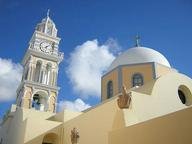Quiz Answer Key and Fun Facts
1. What is the geographical feature indicated by the name Acheron?
2. Where is the city of Thebes?
3. The Sporades island of Gioura is no longer inhabited by humans. In 1991 there was one inhabitant, but some years later this person died. What was the ancient Greek name for Gyoura, a name that is related to old age?
4. Where was the most important oracle in Greece?
5. On to E for Epsilon. In which city can you still visit the famous theatre?
6. We've already reached Z - the Greek letter zeta, the sixth letter of the Greek alphabet. Which of these is an island in the Ionian Sea? I've preferred here the original Greek name, for reasons I'll explain in the info section.
7. The following place names all start with the long e, known in Greek as the eta (ή in minuscule, Η in capital). Which of these was and still is a region in the northwest of the Greek mainland?
8. One of the best known battles between Greeks and Persians was fought at a mountain pass of which the name starts with theta (TH). Where did a small army led by Spartans halt the Persian army for several days, against incredible odds?
9. Which island was in Greek myth mentioned as the home of Odysseus and his family?
10. Which Peloponnesian harbour city is nowadays known for very tasteful black olives?
11. On which island did the poet Sappho live all of her life, except for a period of exile to Sicily?
12. Which ancient Greek city (now in ruins) is the site where the famous Lion's Gate was excavated, as well as several tomb complexes?
13. Which of these place names is an island that has given its name to a music publisher?
14. It was hard to find a Greek place name starting with the letter X (xi). But in Western Thrace there is such a city: Xanthi, a city with many bright coloured houses in the old town. What is the literal translation of Xanthi?
15. Which is Greece's highest mountain?
16. According to the literal text, the Bible book of Revelation was written by John when he was on a certain Greek island. What was the name of the island?
17. Which island may not seem colossal, but was known for a Colossus?
18. On which Greek island did a French archaeologist find the remnants of a beautiful statue of a winged goddess?
19. Which mountain range is in the Peloponnese peninsula, separating the towns of Sparta and Kalamata?
20. Which of these place names is the ancient Greek name of a city in the region of East Macedonia and Thrace?
21. On which small island in the Dodecanese did Hippocrates glean medicinal plants? Those of you who've studied (ancient or modern) Greek, have a great advantage in answering this question.
22. Which of the following places is a peninsula on the Greek mainland?
23. All of the following are Greek place names, except for one. Which mythical character has NOT inspired a Greek place name?
24. There are only a few Greek place names that start with omega (the long O). Which of these is a town on the frontier between Attica and Boeotia?
Source: Author
JanIQ
This quiz was reviewed by FunTrivia editor
agony before going online.
Any errors found in FunTrivia content are routinely corrected through our feedback system.
